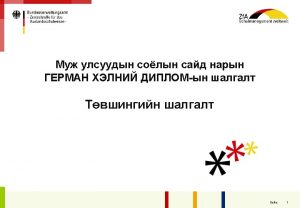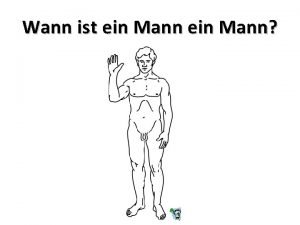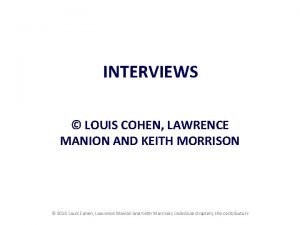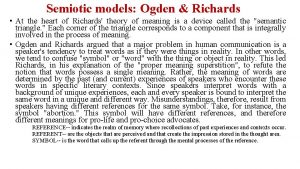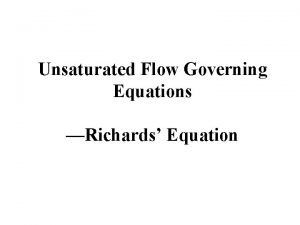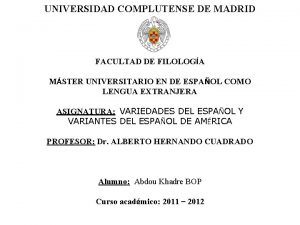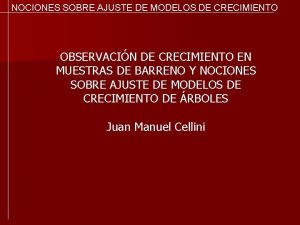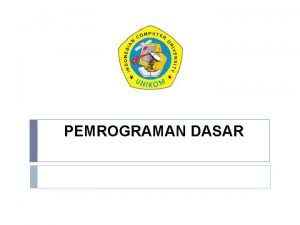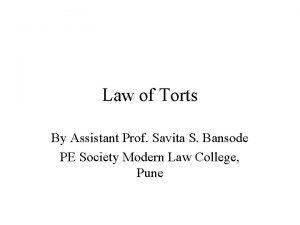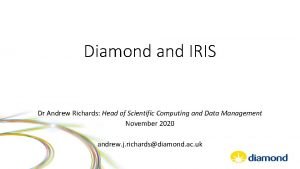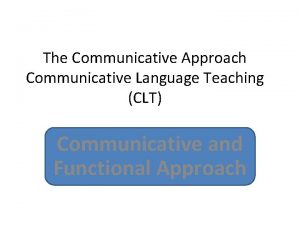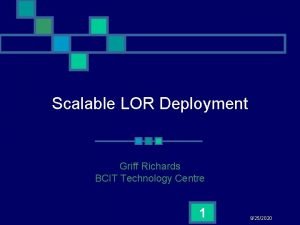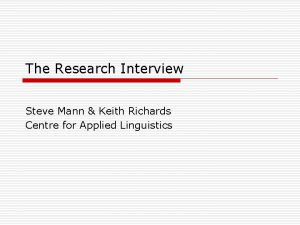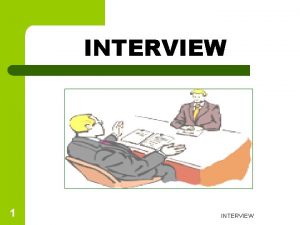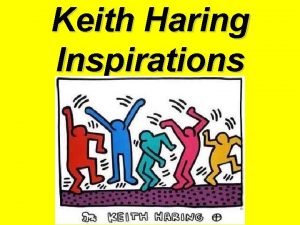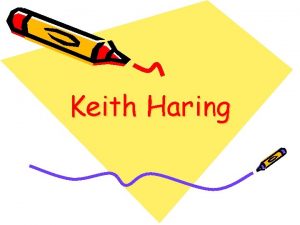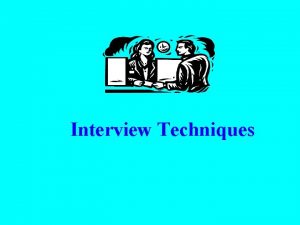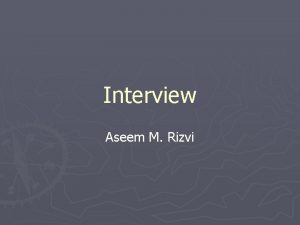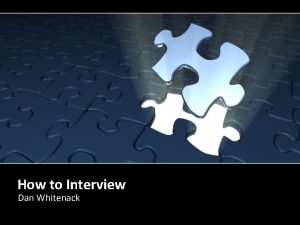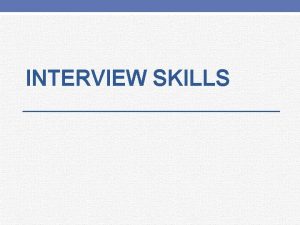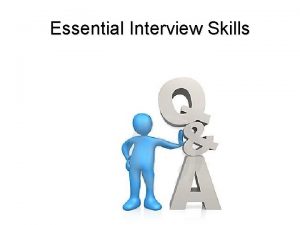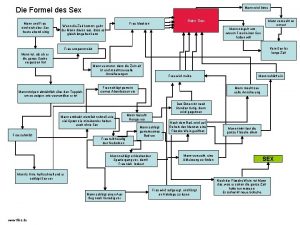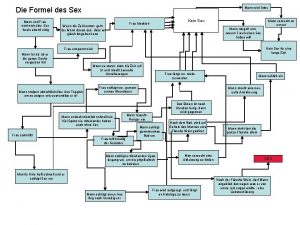The Research Interview Steve Mann Keith Richards Centre




















- Slides: 20

The Research Interview Steve Mann & Keith Richards Centre for Applied Linguistics

Part 1: Interview technique Keith Richards

Learning outcomes: Interview technique At the end of this session you should be able to: o explain the nature and defining characteristics of the research interview; o identify different types of interview; o describe the procedure for setting up and conducting effective interviews; o summarise the main issues in interview evaluation; o identify different analyse an interview for the purpose of improving questioning technique.

A quick characterisation ‘conversation with a purpose’ Burgess 1984: 102 ‘professional conversation’ Kvale 1996: 5

Interview types (1) Structured An interview in which all the questions are laid down in advance is better regarded as a spoken questionnaire. Semi-structured This is the most common form of interview, combining flexibility with control Open Although this focuses on specific areas, its structure is much looser than that of the semi-structured interview and its direction relatively unpredictable.

Interview types (2) o o Ethnographic Narrative Life history ‘Elite’ etc. o Group o Telephone o Skype

Discursive practices However well prepared you feel yourself to be, however well you have tried to design the interview questions in a style that your informants would not be put off by, in the actual interview, you will need to rapidly learn the specific way this unique informant speaks to you on this unique occasion: you will need to learn their ‘idiolect’ (discursive practices). Wengraf, T. 2001. Qualitative Research Interviewing. London: Sage. Page 64.

Developing an interview guide 1. Decide on what the interview is setting out to achieve 2. Identify the big questions 3. Decide on lines of inquiry deriving from these 4. Write a suitable warm-up question 5. Analyse, apply, review, revise 6. Pilot

Progressive focusing How do you feel about doing X? When someone does X, how do you respond? What are the pluses and minuses of that response? Do you think it would work for everyone? etc. If you had to recommend a particular type of X to a new employee, what would it be? What features made you choose this? Examples of use from your own experience. Variations?

Indirectness What’s your view of approach X? If you were interviewing candidates for a post here and they described themselves as using approach X, what questions would you ask to check this out? How important do you think office arrangement is? Show photos of different arrangements. Should a teacher ever get personally involved with a student? Tell story and ask them their response as principal.

Elicitation techniques o taxonomic elicitation (Johnson and Weller 2002) Asking respondent to develop a taxonomy, or structured set of items and their relationships. E. g. ‘What different kinds of X do you have to deal with? ’ o free recall (Johnson and Weller 2002) Ask respondent to recall as much as possible on a single topic. E. g. ‘List all the checks you need to make for X. ’ use of evocative objects or taking the informant to a key site and walking around it with them. o Object and walking probes (De Leon and Cohen 2005) Use evocative objects or take the respondent to a key site and walk around it with them. o graphic elicitation (Bagnoli 2009)

Question types o Opening Get the respondent talking o Check/reflect Explicit check or reflect back to speaker o Follow up Invite expansion/development of point o Probe a point (question, explore, interrogate) o Structuring Signal shift of topic

Degrees of directiveness (1) o ‘Uh-huh, ’ nod of head etc. Encourages the informant to continue without directing the form of the response. o Reflection Reflects the interviewee’s words back to them. o Probe the informant’s last remark Responds to the interviewee’s statement with a comment or question (e. g. ‘When you say you thought the clerk was wrong, was this because you think that sort of thing is always wrong or because it worked out badly in this particular case? ’).

Degrees of directiveness (2) o Probe an idea in preceding turn Probes an idea preceding the final remark but within the interviewee’s prior statement (e. g. ‘You said the his response was arrogant. What do you mean by that? ’). o Probe an idea introduced earlier The interviewer picks up an idea from earlier in the interview (e. g. ‘Earlier you said that a sense of humour is important. Where do you think you should draw the line? ’). o Introduce a new topic The interviewer introduces a topic that has not been referred to before. (Whyte 1984: 99 -100)

Some do’s and don’t’s Do Don’t o listen carefully close off interviewee space o offer supportive feedback interpret for the interviewee o respond to emotion judge o let the interview take stick rigidly to the topics its own shape you think are important monitor your responses in order to give the interviewee proper space interrupt unthinkingly o

Advantages of the group interview o Enables the researcher to get a sense of issues as they affect a group and to identify areas of disagreement, shades of opinion and strength of feeling. o Less likely to involve issues of ‘front’ that an individual interviewee might present. o Composition of the relevant group can be carefully determined. o Allows a greater number of people to be interviewed.

Challenges of the group interview o Ensuring that everyone gets the chance to contribute. o Handling the dominant character(s). o Excellent moderator/facilitator skills required. ‘[t]he intent of the focus group is to promote selfdisclosure among participants. ’ (Krueger and Casey 2000: 7)

Group interview procedures o The most effective number of interviewees is between 6 and 8 o Arrange in a circle to optimise interaction among members. o Good idea to have drinks and snacks available. o Begin with an introduction explaining why the members have been chosen, introducing the topic and approach, and dealing with ethical issues such as confidentiality. o Allow a short pause after any contribution, leaving time for responses from other participants who may need a few seconds of thinking time. o At the end, check what has emerged from the discussion.

The interview as data generation As Baker (1997: 139) points out, interviews involve not data collection but data generation. This perspective has a number of implications: n Interviews are jointly constructed events. This process of construction involves both parties, each of whom might ‘membership’ themselves in different ways, so that the developing interaction ‘serves to add to and elaborate on the categories and activities proposed in the initial description’. n Questions are integral parts of this and not merely neutral invitations to speak, and they should therefore be treated as a key part of the data. n Interviews should be read as accounts not reports.

References Bagnoli, A. (2009). Beyond the standard interview: the use of graphic elicitation and arts based methods. Qualitative Research, 9(5): 547– 570. Burgess, R G. (1984). Autobiographical accounts and research experience. In R. G. Burgess (ed. ), The Research Process in Educational Settings: Ten Case Studies, pp. 251 -270. Lewes: The Falmer Press. De Leon, J. P. and Cohen, J. H. (2005). Object and walking probes in ethnographic interviewing. Field Methods, 17(2): 200 -204. Johnson, J. C. and Weller, S. C. (2002). Elicitation techniques for interviewing. In J. F. Gubrium and J. A. Holstein (eds), Handbook of Interview Research: Context and Method, pp. 491 -514. Thousand Oaks: Sage. Krueger, R. A. & Casey, M. A. (2000). Focus groups: A Practical Guide for Applied Research (3 rd Edition). Thousand Oaks, CA: Sage. Kvale, S. (1996). Inter. Views: An Introduction to Qualitative Research Interviewing. Thousand Oaks: Sage. Wengraf, T. (2001). Qualitative Research Interviewing. London: Sage. Whyte, W. F. (1984). Learning from the Field. Beverly Hills CA: Sage.
 Michael mann anthony mann
Michael mann anthony mann Männer herbert grönemeyer analyse
Männer herbert grönemeyer analyse Agile krc
Agile krc Keith morrison interview
Keith morrison interview Steve jobs steve wozniak ronald wayne
Steve jobs steve wozniak ronald wayne Centroid statics
Centroid statics Center of gravity
Center of gravity Gordon richards drexel
Gordon richards drexel Semantic triangle ogden and richards
Semantic triangle ogden and richards Eletelephony poem questions and answers
Eletelephony poem questions and answers Richards' equation
Richards' equation Triangulo de ogden y richards
Triangulo de ogden y richards Eric richards seminary
Eric richards seminary Modelo de richards
Modelo de richards Ia richards principles of literary criticism
Ia richards principles of literary criticism Martin richards
Martin richards Tort and contract difference
Tort and contract difference Dr andrew richards
Dr andrew richards Communication activities examples
Communication activities examples Griff richards
Griff richards Eugene richards the fat baby
Eugene richards the fat baby
